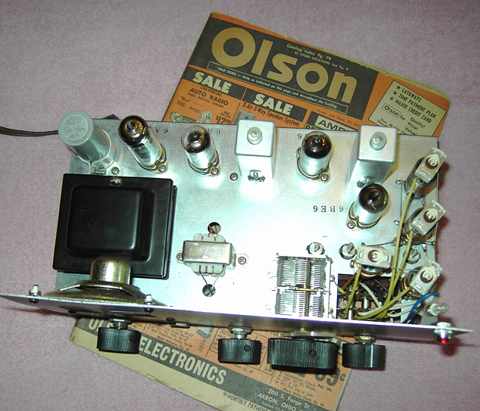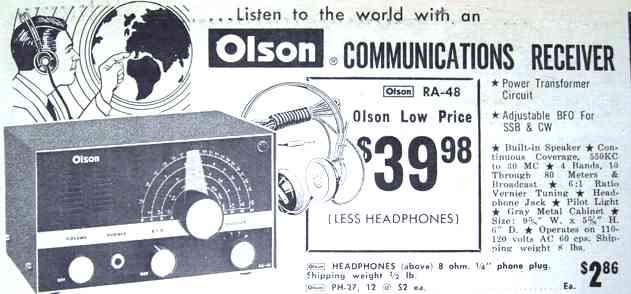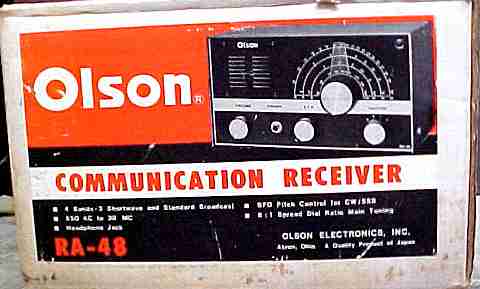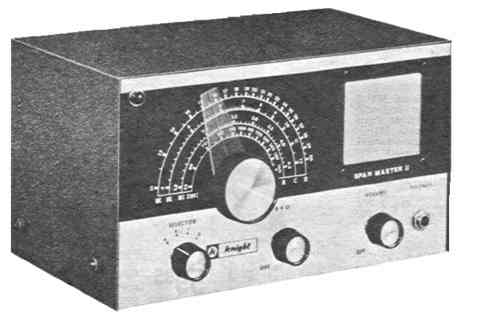
Olson RA-48 Receiver

Frequency coverage is 550KHz to 30 Mhz in four bands. It is transformer operated and single conversion with an IF of 455 KHz. The set has 4 tubes including a 6BE6 oscillator, a 6BA6 IF amplifier, 6AV6 for detector/ first audio, 6AR5 for audio output. It uses a half wave diode rectifier. The BFO is regenerative and variable. I was surprised at how well the BFO worked with such minimalist circuitry when carefully adjusted. While the tuning is a vernier drive, the lack of bandspread makes tuning a bit difficult for SSB. However, I did listen to a few SSB exchanges on 75 meters. The BFO can also be used to boost the sensitivity of the set for standard AM signals in a manner similar to that of a regenerative set.

In good electronic condition
This radio was in very good cosmetic condition. The volume and BFO controls have been replaced. I powered the set up slowly to reform the electrolytic. The set began working rather well. All of the alignment points still had the original white paint-locks on (a bit of paint was used to keep each alignment screw adjustment in place for shipping and to make it obvious if the radio alignment had been "diddled" with.) Since the radio played very well and seemed to be in reasonable alignment, I decided to leave it at those factory settings.
Olson advertisement
The RA-48 was advertised in several Olson "flyer" catalogs in 1968.

This example is serial number 121. I believe the RA-48 to be relatively rare. If you own one, let me know what serial number is on yours. If you have the schematic, please scan for reference for other owners.
Notes from other RA-48 owners

Terry W8TF wrote to say that his RA-48 serial number is 580. He added, "It is in nice shape, and is on the list for repair (hums - needs some recapping) this winter along with some TO's. I don't have any documentation or schematics but if I find something I'll pass it along."
Yours obviously works better than mine! What I could have added would be:
1. Drifts like the clappers.
2. Deaf as a post, especially on higher freqs.
3. Whistles on Medium Wave.
4. Only 2-core power lead: chassis floats and makes you jump if you touch it and earth simultaneously! I think that the transformer had two 110v primaries: presumably wired in parallel for the US version, and series for the UK.
5. Riddled with images: not just the usual f + (2 x i.f.) but umpteen variations on (l.o. x n) ±455 and goodness knows what else.
It eventually developed some sort of "self oscillation" fault and I gave it away to someone who probably stuck it in the attic until his XYL made him throw it out. :0)
I think you are right about them being quite rare. There is VERY little on the internet about any of the Unica radios ---
I wish I still had it. With the knowledge I now have, I could probably fix it (probably a decoupling cap gone) and align it properly ---
Best 73, Mark G0OIW
Robert Furtado wrote to say that his Olson RA48 is serial number 564
Compared with Knight Span Master II
Allied Radio advertised a similar Knight "Span Master II" shown in this 1970 Allied Catalog picture. In design, it appears to be almost a mirror image of the RA-48. However, the Span Master II uses 5 tubes of the "All-American 5" AC-DC series filament variety (12AV6, 12BA6, 12BE6, 35W4 and 35C5 in place of the usual 50C5). It includes an isolation transformer that I assume also drops the voltage for the series string closer to the Japanese standard of 100 volts. The IF transformers and certain other parts are identical to those in the RA-48. It was available in kit form and is likely from the same Japanese supplier. As noted, the design for both appears to be inspired by the Hallicrafters S-119 Sky Buddy II. That makes me wonder if the S-119 also had a Japanese parts supplier connection.

A Measurements model 59 grid dip meter was the previous item on the bench.